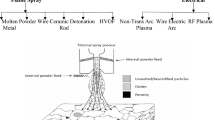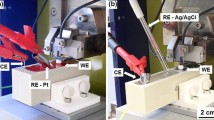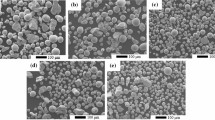We explore the efficiency of fuel pumps by modifying the friction surfaces with fluor-oligomeric films, analyze the peculiarities of interaction between the fluor-oligomer and iron, and investigate the influence of fluor-oligomer on the corrosive properties of iron. After processing the surfaces of precise friction pairs with fluor-oligomer, the average cyclic delivery of fuel pumps increases by up to 18%, and the elevated efficiency persists for 40 hours of operation. The fluor-oligomer lowers wear as compared with the control version, especially at higher rotation speeds. The positive effect is explained by the chemical interaction between iron and the fluoroligomer film as follows from the data obtained by the Mössbauer spectroscopy, the X-ray diffraction analysis, and electrochemical technique. Even extremely thin fluor-oligomeric films (down to 2 µg · cm–2 ) may sufficiently improve the corrosion resistance of iron.
Similar content being viewed by others
References
V. S. Isakovich, V. A. Struk, V. A. Gubanov, and P. A. Troichanskaya, “The influence of hydrophobic chemosorbic films on the tribotechnical characteristics of pairs: metal–metal and polymer–metal,” Tren. Iznos, 13, No. 2, 306–310 (1992).
E. V. Ovchinnikov, Structure and Properties of Tribotechnical Coatings Based on the Fluorine-Containing Oligomers [in Russian], Ph. D. Thesis, Gomel (1997).
L. Adamczyk, P. J. Kulesza, and H. Bala, “Electropolymerization of 3.4-ethylenedioxythiophene (EDOT) with 4-(pynole-l-yl) benzoic acid (PyBA) at stainless-steel electrode: corrosion protection properties,” Fiz.-Khim. Mekh. Mater., Special Issue, No. 7, 368–373 (2008).
I. O. Delikatnaya, “On the estimate of the effect of components of the lubricant on sliding friction,” Friction Wear, No. 5, 686–689 (1996).
J. Padgurskas, R. Rukuiža, M. Vötter, and V. Wollesen, “New tribotechnical materials for the friction pair ‘radial lip seal–shaft’,” Industr. Lubric. Tribol., 51, No. 5, 233–238 (1999).
W. Liu, C. Ye, Y. Chen, et al., “Tribological behavior of sialon ceramics sliding against steel lubricated by fluorine-containing oils,” Tribol. Int., 35, No. 8, 503–509 (2002).
K. P. Thiessen, E. Winkler, and U. Noack, “Niedriger Reibwert durch fluorhaltige Reaktionsschichten,” Tribol. Schmierungstechnik, 44, No. 5, 203–207 (1997).
J. Padgurskas and R. Rukuiza, “Changing the tribosystem through modification of the friction surface with fluoroligomers,” in: Handbook of Tribology and Lubrication, Vol. 10: New Horizons for Tribology and Lubricants, Expert-Verlag, Renningen (2002).
P. Thomas, K. Delbe, D. Himmel, et al., “Tribological properties of low-temperature graphite fluorides. Influence of the structure on the lubricating performances,” J. Phys. Chem. Solids, 67, No. 5–6, 1095–1099 (2006).
V. V. Tsukruk, “Nanocomposite polymer layer for molecular tribology,” Tribol. Lett., 10, No. 1–2, 127–132 (2001).
E. V. Ovchinnikov and V. A. Struk, “Lubricating properties of thin films of fluorine-containing oligomers,” in: Proc. of the 12th Internat. Colloquium on Tribology, 2000-Plus, Vol. 3, TAE, Ostfildern (2000), pp. 2153–2155.
H. Cesiulis and G. Baltrunas, “The study of surface passivity and blocking by the electrochemical technique,” Fiz.-Khim. Mekh. Mater., 42, No. 5, 11–17 (2006).
V. I. Lichtman, E. D. Shchukin, and P. I. Rehbinder, Physicochemical Mechanics of Materials, Akad. Nauk SSSR, Moscow (1962).
D. N. Garkunov, Tribotechnology (Wear and Nonwear), A Textbook [in Russian], Moscow (2001).
R. Hoffman, Solids and Surfaces: A. Chemist’s View of Bonding in Extended Structures, VCH Publishers, New York (1988).
A. Amulevicius, A. Daugvila. R. Davidonis, et al., “Interaction of fluoroligomer with steel and iron,” in: Mater. of the 12th Internat. Baltic Conf. “Engineering Materials & Tribology,” Riga, Latvia (2004), pp. 179–183.
A. Amulevicius, J. Padgurskas. C. Sipavicius, et al., “Influence of fluor-oligomeric coat to the surface of steel,” in: Proc. of the Internat. Conf. Baltrib’2005, Kaunas (2005), pp. 29–34.
R. F. de Boer, R. Boom, W. C. M. Mattens, et al., Cohesion in Metals: Transition Metal Alloys, Elsevier, Amsterdam (1988).
G. W. Walter, “A review of impedance plot methods used for corrosion performance analysis of painted metals,” Corr. Sci., 26, No. 9, 681–703 (1986).
A. Królikowski, “The modern examination methods of corrosion resistance in the presence of protecting coatings,” Chasop. Inst. Mech. Prec., 87–88, No. 5–6, 2–8 (1987).
Y. J. Tom and S. Bailey, “An investigation of the formation and destruction of corrosion-inhibitor films using electrochemical noise analysis (ENA),” Corr. Sci., 38, No. 9, 1545–1561 (1996).
H. B. Wang, “Characterization of inhibitor and corrosion product film using electrochemical impedance spectroscopy,” Corrosion, Paper No. 01023 (2001).
R. G. Duarte, A. C. Bastos. A. S. Castela, and M. G. S. Ferreira, “A comparative study between Cr(VI)-containing and Cr -free films for coil coating systems,” Progr. Organ. Coat., 52, 320–327 (2005).
Author information
Authors and Affiliations
Corresponding author
Additional information
Published in Fizyko-Khimichna Mekhanika Materialiv, Vol. 45, No. 5, pp. 81–90, September–October, 2009.
Rights and permissions
About this article
Cite this article
Padgurskas, J., Rukuiza, R., Cesiulis, H. et al. The properties and physicochemical interactions in iron–fluor-oligomer systems. Mater Sci 45, 702–714 (2009). https://doi.org/10.1007/s11003-010-9234-z
Received:
Published:
Issue Date:
DOI: https://doi.org/10.1007/s11003-010-9234-z




